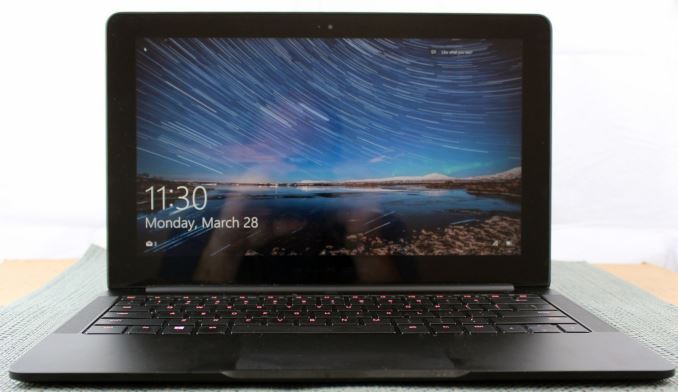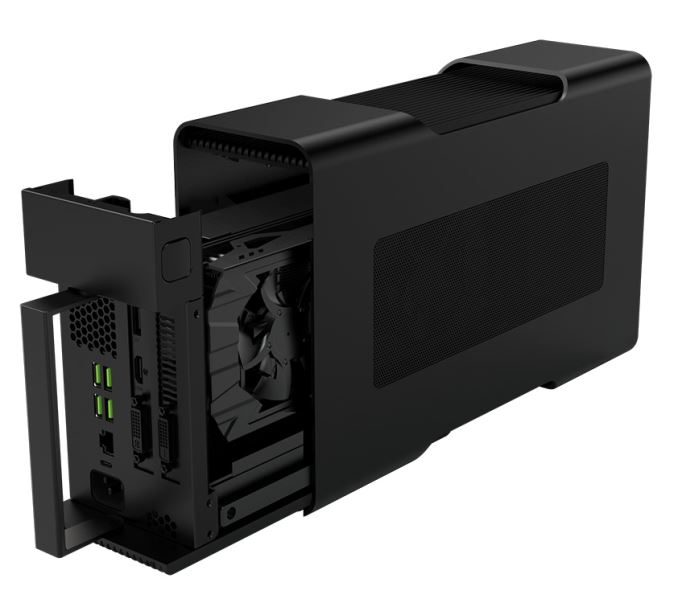The Razer Blade Stealth Review: Razer Takes On The Ultrabook
by Brett Howse on March 29, 2016 8:00 AM EST- Posted in
- Laptops
- Razer
- Skylake
- Razer Blade Stealth
- eGFX
- Razer Core
- Skylake-U

Razer has traditionally been a company focused on gaming. In fact, their tagline is “For Gamers. By Gamers.” So when Razer announced at CES that they were building an Ultrabook – a product category whose size and power limitations are typically the antithesis of gaming – it was a bit surprising. Razer decided it was time to branch out into more of the mainstream of PC hardware, but of course with the Razer twists they are known for. The Razer Blade Stealth is not your typical Ultrabook, and one of the biggest twists of all is that it can be docked to a desktop GPU to actually enable gaming.
The Razer Blade Stealth is a stand-alone product, so we can’t assume everyone that buys it will purchase the first Thunderbolt 3 external graphics dock which Razer developed for it, but the Razer Core is certainly an interesting addition to the notebook. We’ll take a closer look at that in the future, but for now the Razer Blade Stealth must be a capable device on its own merits.
When you talk about value, it doesn’t mean low cost. The Razer Blade Stealth is not an inexpensive notebook, but when you look at what kind of technology is inside, the value proposition starts to have some merit. Razer, has traditionally offered the high quality Razer Blade 14, but it was never as inexpensive as the competition. With the Razer Blade Stealth, as well as the new pricing on the Razer Blade 14, the company appears to want to reach a much wider audience.
The 12.5-inch Razer Blade Stealth (which for the sake of brevity I'll refer to as simply the Stealth) starts at $999, which makes it one of the most inexpensive Ultrabooks available with a Core i7 processor. There are not different models with Core i3/i5/i7, but instead every Stealth ships with a Core i7-6500U. The Dell XPS 13, as an example, only offers the i7 on the most expensive models, which are over $600 more expensive. Instead of processor based models, Razer is segmenting their models by offering two different displays: a base offering with a sRGB QHD 2560x1440 panel, and a higher-end model with an Adobe RGB UHD 3840x2160 panel. There are also three storage offerings, with 128 GB and 256 GB available on the QHD model, and 256 GB and 512 GB on the UHD version. All storage is provided by Samsung’s PM951, which is a PCIe 3.0 x4 NVMe drive with TLC NAND.
| Razer Blade Stealth | |||||
| QHD | UHD (As Tested) | ||||
| CPU | Intel Core i7-6500U Dual-Core with Hyperthreading 2.5-3.1 GHz, 4MB Cache, 15W TDP |
||||
| GPU | Intel HD 520 300-1050MHz, 24 Eus |
||||
| Memory | 8GB LPDDR3-1866 Dual-channel | ||||
| Display | 12.5-inch IGZO 2560x1440 sRGB with touch |
12.5-inch IGZO 3840x2160 Adobe RGB with touch |
|||
| Storage | 128-256GB PCIe NVMe Samsung PM951 |
256-512GB PCIe NVMe Samsung PM951 |
|||
| I/O | USB 3.1 Type-C x 1 with Thunderbolt 3 USB 3.0 Type-A x 2 Headset jack 2.0MP Webcam HDMI |
||||
| Dimensions | 321 x 206 x 13.1 mm 12.6 x 8.1 x 0.52 inches |
||||
| Weight | 1.25 kg / 2.75 lbs | ||||
| Battery | 45 Wh, 45 W AC Adapter (USB-C) | ||||
| Keyboard | Chroma anti-ghosting keyboard with individually backlit keys | ||||
| Wireless | Killer 1535 802.11ac 2x2:2 with Bluetooth 4.1 |
||||
| Price | $999.99-$1199.99 | $1399.99-$1599.99 | |||
Looking at the rest of the product, we can see that Razer has decided to move to Killer’s networking solution, which fits in more with their gaming aspect, but the latest Killer products have been reliable in my experience too, so I think this is not a bad move. Razer offers a single Thunderbolt 3 port over USB-C, which doubles as the charging port for the laptop. When docked to the Razer Core, this is a single cable docking solution which does the external graphics and I/O as well as laptop charging. In addition, there are two USB 3.0 ports on the laptop, along with an HDMI port, but there is no SD card reader.
The 8 GB of memory is really the minimum that would be acceptable in a 2016 Ultrabook, and there’s no option for more memory which is unfortunate. But other than that, Razer offers quite a bit of notebook for the $999 starting price. Though personally I suspect that $1199 is going to be the sweet spot, as it offers 256 GB of storage and the QHD display.











66 Comments
View All Comments
forgot2yield28 - Thursday, March 31, 2016 - link
Won't benefit the end user? Are you kidding? If you do any kind of work viewing fine vector images, such as architectural displays, a high DPI display is a godsend. For productivity software, if you have good eyesight and don't mind shrunken UI elements, you fit your work on more of the screen. It's obviously a tradeoff against battery life, but it's a tradeoff some would gladly make. It's simply not true to state there are zero use cases where a high DPI display provides a tangible benefit.niva - Friday, April 1, 2016 - link
You can disagree all you want, but anything below 1080p should be immediately disqualified from being purchased 5 years ago. An argument about 1080p for the sake of efficiency can be made, but discouraging companies from adopting higher resolution standards is just wrong. The UHD display can be ran as a 1080 for performance purposes.moozooh - Saturday, April 2, 2016 - link
> An Intel GPU in a 12.5 inch laptop display that is unable to drive games at much lower resolutions should be paired with a 1366x768 panel of decent quality with good viewing angles.That is just silly. Gaming performance is never a goal with laptops of this form-factor, not even a secondary one. If you're looking for any kind of decent gaming performance you shouldn't be considering an Ultrabook at all. Their primary task is the ability to handle large amounts of text, non-computanionally-intensive media work, and internet browsing/media consumption on-the-go for as long as possible without having to be plugged in. The difference between a 120 dpi panel and a 190+ dpi panel when working with text or photos is MASSIVE. They aren't even comparable, not if you value your eyesight and comfort at all. Had you experienced that you would never write the nonsense about 768p panels.
deeps6x - Wednesday, April 6, 2016 - link
Which is why they should have had a 1080P option with a nice Matte IPS screen. 13.3", not the micro size they went with. It fits. Use it Razor. You build this fine ass machine then gimp it with the large bezels. If Dell can do it you can do it as well, if not better.Why 1080P? Because it uses less power than 3k or 4k, and extends battery life. Why matte screen? Because touch is Intel forced cow poop, and I like to be able to use my laptops with windows behind me. Or even outside. I don't know what kind of profit Intel makes by insisting touch screens are part of the 'Ultrabook' spec, but it is one of their dumbest ideas ever. Touch on a tablet? Of course. Touch on a laptop? Useless.
jlabelle - Thursday, April 28, 2016 - link
- Higher resolution displays, while nice looking, offer little to no added functionality after reaching the point -So...it does !
And let's be honest, we are still far from smartphone resolution. I am not pushing for 4K display on a 12" screen but there is a CLEAR difference between 768p and QHD on such size.
- after reaching the point where it becomes necessary to scale the interface in order to retain visibility of objects displayed in it -
Which is not a issue per see. Windows Store applications and UI just scaled perfectly. It is old legacy software that needs to be adapted for that so indeed, it is a good thing to evolve in this direction to force the software manufacturer to make their homework as high DPI support exists on Windows since more than 7 years.
- Anything more than that won't benefit the end user regardless of how much they think they need more pixels.-
It does. What does NOT is the aRGB screen, which, as explained, for most of the operation is detrimental to the user experience.
mikesackett.85 - Thursday, March 31, 2016 - link
768 is awful, 1080p should be the minimum. Having been spoiled by nice high DPI screens (1600-1700p) I'll never go back to anything less than FHD. For me the QHD model hits the sweet spot at $999.99, for that you get an i7, 8GB Ram, 128GB SSD, and QHD touchscreen, which is higher specs than the similarly priced XPS 13 (i5, 1080p, 8GB RAM, 128GB SSD, non-touch) and a similar specced MBP is $1299. This laptop also has the added bonus of having a thunderbolt connected dGPU which none of the other options have (Though the Razer dock should work on other pc's with thunderbolt ports, including the Dell XPS 13). This laptop has the ability to serve both as a road warrior and in-home gaming machine, for that I feel it is absolutely worth the price of admission.Kristian Vättö - Tuesday, March 29, 2016 - link
I agree. The battery life is a big drawback considering that the competitors offer nearly twice the battery life.A part of my wonders why won't Razer offer a model for the normal consumer. Kill the fancy keyboard backlight and offer i3 and i5 CPUs, and the Stealth could be very competitive against the likes of Dell and ASUS. I know Razer is all about gamers, but the Stealth looks like a very solid machine and given Razer's higher-end brand status and quality I'm sure they could reach a wider audience with just a few small tweaks.
zeroqw - Tuesday, March 29, 2016 - link
Exactly. I have been monitoring the ultrabook market for 2 years and to be honest this laptop could have been a big hit with real battery life. It feels like all the ultrabook laptops got some smaller or bigger drawbacks and you just cant get what you pay for. I just hope they consider moving closer to a wider audience in the future.nerd1 - Tuesday, March 29, 2016 - link
They can provide FHD (matte) screen with i5 version at $799, which should last twice longer than this.ImSpartacus - Tuesday, March 29, 2016 - link
Since at first glance, it appears that Razer is emulating parts of Apple's strategy, I would guess that Razer is ensuring that every modern system in the Razer "ecosystem" can have a satisfactory experience with their Core.The Blade 14 & 17 are both easily up for the task. And Razer at least attempted to ensure that every Stealth will be a good match for the Core. However, if they put a weaker 15W CPU in there, then it might not perform as well with the Core.
Is that the right thing to do? Objectively no, but I wonder if that kinda of Apple-esque way of thinking of part of the reason why the Blade laptops seem to be so cool in the first place. You take the good with the bad, I guess.